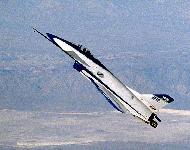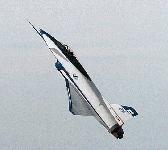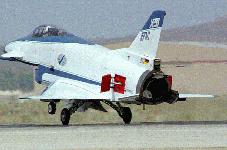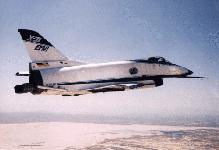FAS |
Military |
DOD 101 |
Systems |
Aircraft ||||
Index |
Search |
Join FAS



X-31 Enhanced Fighter Maneuverability Demonstrator
The X-31 Enhanced Fighter Maneuverability (EFM) demonstrator, flown at NASA's Dryden Flight Research Center, Edwards, Calif., provided information which is invaluable for proceeding with the designs of the next generation highly maneuverable fighters.
The X-31 program showed the value of using thrust vectoring (directing engine exhaust flow) coupled with advanced flight control systems, to provide controlled flight to very high angles of attack. The result is a significant advantage over conventional fighters in a close-in-combat situation.
"Angle-of-attack" (alpha) is an engineering term to describe the angle of an aircraft's body and wings relative to its actual flight path. During maneuvers, pilots would like to fly at extreme angles of attack to facilitate rapid turning and pointing against an adversary. With older aircraft designs, entering this flight regime often led to loss of control, resulting in loss of the aircraft, pilot or both.
Three thrust vectoring paddles made of graphite epoxy and mounted on the X-31's aft fuselage are directed into the engine exhaust plume to provide control in pitch (up and down) and yaw (right and left) to improve maneuverability. The paddles can sustain temperatures of up to 1,500 degrees centigrade for extended periods of time. In addition, the X-31s is configured with movable forward canards, wing control surfaces, and fixed aft strakes. The canards are small wing-like structures located just aft of the nose, set on a line parallel to the wing between the nose and the leading edge of the wing. Normally "weathervaned" with the prevailing airflow, these devices are programmed to be used for aerodynamic recovery from high angles of attack in event of thrust vectoring system failure. The strakes are set along the same line between the trailing edge of the wing and the engine exhaust. The strakes supply additional nose down pitch control authority from very high angles of attack. Small fixed nose strakes are also employed to help control sideslip.
The X-31 flight demonstration program was focused on agile flight within the post-stall regime, producing technical data to give aircraft designers a better understanding of aerodynamics, effectiveness of flight controls and thrust vectoring, and airflow phenomena at high angles of attack. This is expected to lead to design methods providing better maneuverability in future high performance aircraft and make them safer to fly.
Phase One
Phase I was the conceptual design phase. During this phase the payoff expected from the application of EFM concepts in future air battles was outlined and the technical requirements for a demonstrator aircraft were defined.
Phase Two
Phase II carried out the preliminary design of the demonstrator and defined the manufacturing approach to be taken. Three major government design reviews were held during the phase to thoroughly examine the proposed design. Technical experts from the U.S. Navy, Federal Ministry of Defense and NASA all contributed to the careful examination of all aspects of the design.
Phase Three
Phase III initiated and completed the detailed design fabrication and assembly of two aircraft. This phase required that both aircraft fly a limited test flight program. The first aircraft rolled out on March 1, 1990, followed by a first flight at Air Force Plant 42, Palmdale, Calif., on Oct. 11, 1990. The aircraft was piloted by Rockwell chief test pilot Ken Dyson, and reached a speed of 340 mph and an altitude of 1 0,000 feet during the initial 38-minute flight.
The second aircraft made its first flight on Jan.19, 1991, with Deutsche Aerospace chief test pilot Dietrich Seeck at the controls.
Flight Summary
During the program's initial phase of flight test operations at the Rockwell Aerospace facility in Palmdale, Calif., the two aircraft were flown on 108 test missions, achieving thrust vectoring in flight and expanding the post-stall envelope to 40 degrees angle of attack. Operations were then moved to Dryden in February 1992 at the request of the Advanced Research Projects Agency (ARPA).
At Dryden, the International Test Organization (ITO) expanded the aircraft's flight envelope, including military utility evaluations that pitted the X-31 against similarly equipped aircraft to evaluate the maneuverability of the X-31 in simulated combat. The ITO, managed by the Advanced Research Projects Agency (ARPA), includes NASA, U.S. Navy, the U.S. Air Force, Rockwell Aerospace, the Federal Republic of Germany, and Deutsche Aerospace (formerly Messerschmitt-Bolkow-Blohm).
The first NASA flight under the ITO took place in April 1992. By July 1992, the X-31 program was continuing the initial stage of post stall envelope expansion.
The X-31 achieved controlled flight at 70 degrees angle of attack at Dryden on Nov. 6, 1992. On the same day, a controlled roll around the aircraft's velocity vector was accomplished at 70 degrees angle of attack.
On April 29, 1993, the No. 2 X-31 successfully executed a rapid minimum radius, 180-degree turn using a post-stall maneuver, flying well beyond the aerodynamic limits of any conventional aircraft. The revolutionary maneuver has been dubbed the "Herbst Maneuver," after Wolfgang Herbst, a German proponent of using post-stall flight in air-to-air combat. The term "J Turn" is also used to describe this type of maneuver, when flown to an arbitrary heading change.
The first tactical maneuver with a cooperative F/A-18 as adversary was accomplished in June 1993. In August 1993, the X-31 demonstrated full capability in flying Basic Fighter Maneuvers.
In October 1993 the program logged its 300th flight. The final tactical evaluation phase, consisting of Close-In-Combat (CIC) tests with unchoreographed flights against the F/A-18 adversary, began in November 1993.
During November and December 1993 the X-31 also reached supersonic speed (Mach 1.28).
A total of 160 flights were completed by the X-31 program in 1993 setting a new annual experimental aircraft record. One of the two X-31s flew 103 of those flights. The program also set a new monthly record of 21 research flights in August 1993.
The evaluation of the X-31's unique capabilities in close combat (CIC) was completed on March 1, 1994.
Evaluation of the X-31 as a fighter maneuverability demonstrator by the ITO is expected to conclude in early 1995.
The No. 1 X-31 ship was lost in an accident Jan. 19, 1995. The pilot, Karl Lang, ejected safely at 18,000 feet before the aircraft crashed into an unpopulated region of the desert just north of Edwards Air Force Base. There was no private property damage.
Quasi-Tailless Demonstration
In 1994, software was installed in the X-31 to demonstrate the feasibility of stabilizing a tailless aircraft at supersonic speed, using thrust vectoring. This software allows destabilization through the control laws of the aircraft in incremental steps to the goal of simulation 100 percent tail-off. Quasi-tailless tests began in 1994. The first phase started with supersonic evaluations at Mach 1.2. Later subsonic evaluations were performed. During the flights the aircraft was destabilized with the rudder to stability levels that would be encountered if the aircraft had a reduced size vertical tail.
The quasi-tailless testing is providing data to industry on the benefits of drag reduction, radar cross section, and weight reduction that could be used for future commercial and military designs and modifications.
Helmet Mounted Visual/Audio Display
Installation of a Helmet Mounted Visual/Audio Display (HMVAD) was completed on the X-31 (aircraft No. 2) in October 1993. The purpose of the HMVAD is to provide out-of-the-cockpit situation awareness and a simulated helmet-mounted sight to the pilot during high angle of attack combat maneuvering.
The system consists of a GEC Viper helmet with symbology projected on its visor by a monocular CRT. Also included is a Polhemus head tracker and an angle-of-attack audio cueing device. Both of these features have been demonstrated on the X-31, during post-stall close-in-combat, a first for any aircraft. This equipment will be the baseline for a follow-on virtual adversary program to demonstrate the feasibility of combat training against onboard and uplinked targets displayed by the helmet.
An international test organization, managed by the Advanced Research Projects Agency (ARPA), is conducting the flight tests. In addition to ARPA and NASA, the International Test Organization (ITO) includes the U.S. Navy, the U.S. Air Force, Rockwell Aerospace, the Federal Republic of Germany and Deutsche Aerospace. About 110 people from the ITO agencies are assigned to the program. NASA is responsible for flight test operations, and aircraft maintenance. Research engineering is an ITO team effort.
The X-31 is the first international experimental aircraft development program administered by a U.S. government agency. It is one, if not the most, successful effort initiated by the NATO Cooperative Research and Development Program.
The X-31 program logged an X-Plane record total of 524 flights in 52 months with 14 pilots from NASA, U.S. Navy, U.S. Marine Corps, U.S. Air Force, German Air Force, DASA, Rockwell International, and Deutsche Aerospace, flying the aircraft.
Specifications | |
Designed and constructed as a demonstrator aircraft by Rockwell Aerospace, North American Aircraft and Deutsche Aerospace.
The X-31 is a single seat aircraft with a wing span of 23.83 feet (7.3 m).
The fuselage length is 43.33 feet (1 2.8 m).
The X-31 is powered by a single General Electric P404-GE-400 turbofan engine, producing 16,000 pounds (71,168 N) of thrust in afterburner.
Typical takeoff weight of the X-31 is 16,100 pounds (7,303 kg).
The X-31's normal flight envelope includes speeds up to Mach 0.9 with an altitude capability of 40,000 feet (12,192 m). For specific tests to determine thrust vector effectiveness at supersonic speeds the aircraft was flown to Mach 1.28 at 35,000 feet.





Sources and Resources
- Successful first flight for VECTOR, X-31 at Pax, by James Darcy, NAS Patuxent River Public Affairs, 28 February 2001 -- The plane demonstrated the combat utility of thrust vectoring in the early 1990s during the Enhanced Fighter Maneuverability project, but was brought out of retirement last year and reconfigured for the Navy's international VECTOR test program.
FAS |
Military |
DOD 101 |
Systems |
Aircraft ||||
Index |
Search |
Join FAS
http://www.fas.org/man/dod-101/sys/ac/x-31.htm
Maintained by Robert Sherman
Originally created by John Pike
Updated Thursday, December 24, 1998 8:13:37 AM